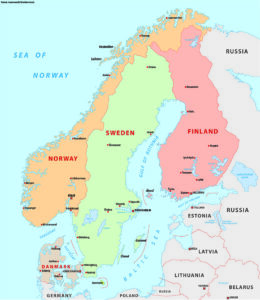Roman Coins Discovered on Swedish Island

Archaeological excavations on an island in the Baltic Sea found 2 denarii, or ancient Roman silver coins. Gotska Sandön is a small, uninhabited island that is part of Sweden. The island is located between Sweden and Estonia. Archaeologists at Södertörn University in cooperation with Uppsala University’s Campus Gotland and the Gotland Museum began excavations in 2020. The archaeological project is researching the history of Gotska Sandön and its coastlines. They discovered the coins in March 2023. The coins date to the times of Roman emperors Trajan (98-117 C.E.) and Antoninus Pius (161 C.E.). Although it is not unusual to find them in the region, these are the first Roman coins found on the small island. Archaeologists say further research is needed to understand more about how the coins got there.
Understanding Context
Coins are important because they have text or images that help archaeologists date their findings. Coins created during the Roman Empire had portraits of the emperor and text about the emperor’s policies or achievements. Like today, the Roman Republic and Roman Empire had different types of coins worth different amounts. The denarius was a type of silver coin that was originally worth 10 bronze coins. It was introduced during the Roman Republic around 211 B.C.E.
At its height in 117 C.E., the Roman Empire extended from Britain to North Africa and from Spain to the Euphrates River in Syria. Scandinavia and the Baltic Sea region were never part of the Roman Empire. Native Scandinavian and Germanic peoples lived in the region at the same time as the Romans. They were in contact with the Roman Empire through trade. Roman coins were traded long after the fall of the Western Roman Empire in the sixth century C.E. Although the coins held no value as currency, Scandinavian and Germanic peoples likely bartered for Roman coins because they contained valuable metals such as silver or copper. Archaeologists have found Roman coins in later Norse, or Viking, sites dating to the ninth century C.E.
Theories on the Coins’ Arrival
However, archaeologists do not know who brought the coins to Gotska Sandön. The team of archaeologists discovered the two denarii on Gotska Sandön using metal detectors. The only other reports of a Roman coin found on Gotska Sandön were from a lighthouse keeper named Hjalmar Söderberg in the nineteenth century. This claim was met with skepticism because archaeologists have not found any evidence of towns or villages on the small island. So, these two coins are considered a first for this island. Roman silver coins have been found on Gotland, a larger island located about 25 miles to the south. Unlike Gotska Sandön, Gotland was home to several ancient towns.
The denarii were found near a beach site that has old fireplaces. Sites such as these were likely created by traders, fishermen, or seal hunters visiting Gotska Sandön. Seals were once hunted for their pelts and their fat, which was used to make oils for a variety of purposes. People would have built fireplaces to cook food and keep warm while waiting out storms or on hunting or fishing trips. As they were discovered near the fireplaces, archaeologists think that the coins could have been brought by Norse traders seeking shelter from storms.
They could also be associated with one of the many shipwrecks found along the coast. The waters around the island are rough and dangerous. Survivors from a shipwreck could have carried the coins ashore.
Another possibility is that Romans brought the coins to the island on a Roman ship. There is evidence of Roman ships sailing as far north as Scotland. Also, Roman authors from the second century C.E. wrote about the Baltic region. However, there are no records of a Roman voyage to the Baltic Sea.
Archaeologists will return to the site later this year to continue their research.
